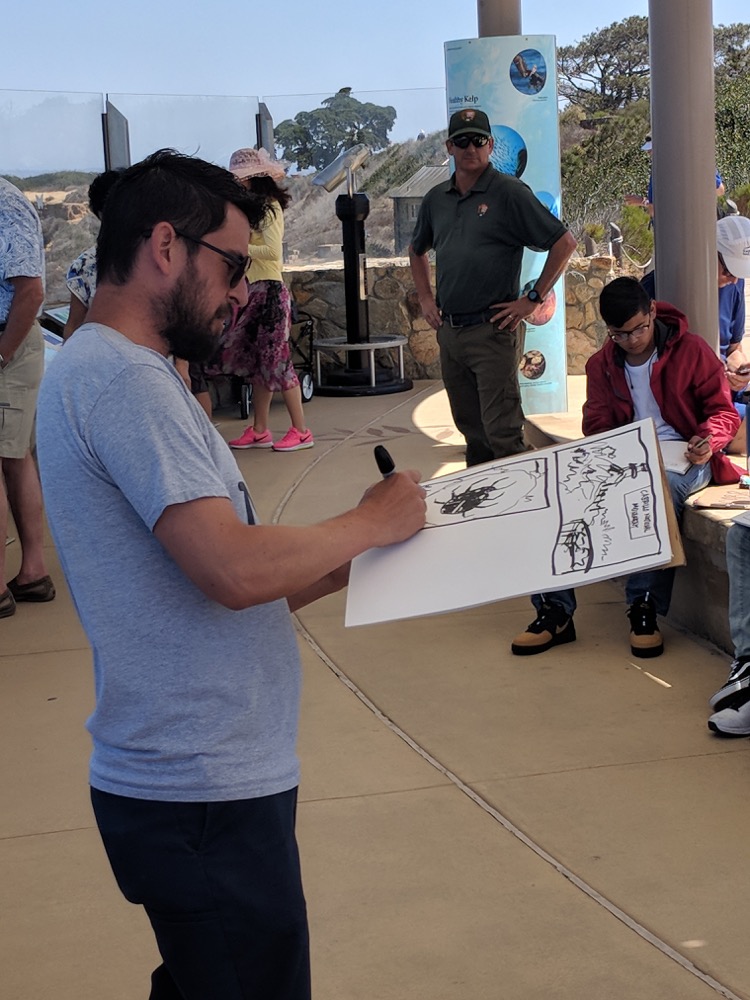Sponsored by a nonprofit called The Kevin Workman Foundation (http://www.kevinworkmanfoundation.org/), staff at CNM’s Science Education Department (http://cabrilloeducation.com/science-programs) created a science lesson with an emphasis on biodiversity. Scientists have three basic tasks to accomplish: observing a problem, finding a solution to that problem, and telling the story aka communicating their science. The Conservation + Comics program investigated these three tasks, emphasizing that students were, acting scientists that day. First, students were introduced to the problem of biodiversity loss and were then led on a guided walk around the Monument to observe the region’s plant and animal species (task 1). After the nature walk, students brainstormed some ways in which they could help to solve the problem of biodiversity loss (task 2). And, finally, Alonso Nuñez from Little Fish Comic Studio (https://www.lilfish.us/) instructed students on how to tell the story of biodiversity loss and solutions therein (task 3).
 NPS Photo/Samantha Wynns – Students from Monarch School observing biodiversity on a nature walk at Cabrillo National Monument
NPS Photo/Samantha Wynns – Students from Monarch School observing biodiversity on a nature walk at Cabrillo National MonumentThe homeless students of Monarch School’s (http://monarchschools.org/) middle school classes selected subject matter that they learned about on their nature walk. With Alonso’s aid, they created a comic that set an establishing shot (a scene of CNM), a close-up of the characters involved (an animal or plant they learned about on their walk), and two panels that illustrate both the threat to the characters and a solution to the problem. For example, some students selected the biotically coupled Shaw’s Agave (Agave shawii) and its primary pollinator, the Mexican Long-tongued Bat (Choeronycteris mexicana). Urbanization is a problem that might be preventing the Mexican Long-tongued Bat from reaching CNM, so some students proposed the solution of introducing the bat species to the Monument. At the end of the lesson, Monarch School’s students were able to define biodiversity, learned that biodiversity is threatened, gained knowledge about the region’s biodiversity, brainstormed solutions to the loss of biodiversity, and communicated all of that science in a fun way. Not bad for a morning’s work!
 NPS Photo/Samantha Wynns – Alonso Nuñez emphasizes that comics use pictures and words to tell a story
NPS Photo/Samantha Wynns – Alonso Nuñez emphasizes that comics use pictures and words to tell a story NPS Photo/Samantha Wynns – Alonso Nunez lays out a storyboard that communicates science
NPS Photo/Samantha Wynns – Alonso Nunez lays out a storyboard that communicates science NPS Photo/Samantha Wynns – A Monarch student creates a comic about the Shaw’s Agave, a plant found at Cabrillo National Monument
NPS Photo/Samantha Wynns – A Monarch student creates a comic about the Shaw’s Agave, a plant found at Cabrillo National Monument NPS Photo/Samantha Wynns – This Monarch student chose to focus on the Peregrine Falcon, Earth’s fastest animal
NPS Photo/Samantha Wynns – This Monarch student chose to focus on the Peregrine Falcon, Earth’s fastest animalIf you’re interested in unique outdoor science education programs like this, check out CNM’s Science Education Department here. Signing up for free ranger-led programs, your students can learn about tidepool ecology, plant adaptations, biodiversity, and much, much more! Hope to see you at the Monument – let’s communicate some science together!
References
Cabrillo National Monument Science Education:
http://cabrilloeducation.com/science-programs
The Kevin Workman Foundation:
http://www.kevinworkmanfoundation.org/
Little Fish Comic Studio:
https://www.lilfish.us/
Monarch School:
http://monarchschools.org/
More on the Shaw’s Agave and Mexican Long-tongued Bat:
https://www.nps.gov/articles/shaws-agave-a-species-on-the-edge.htm
